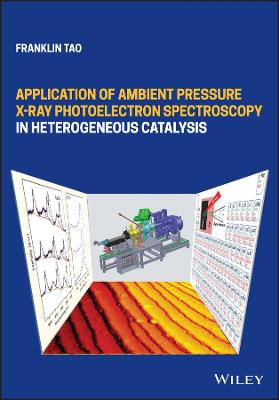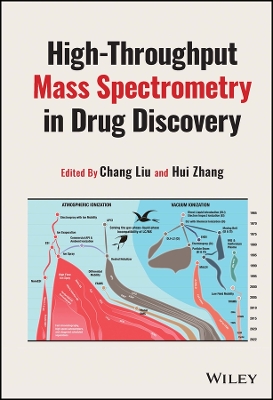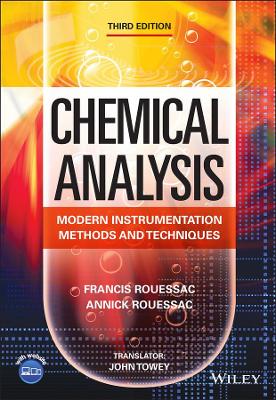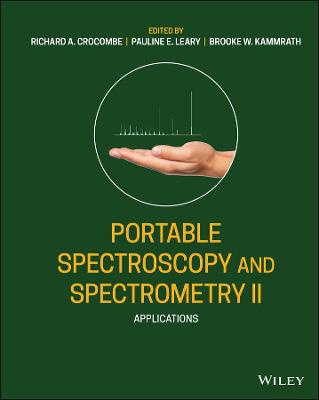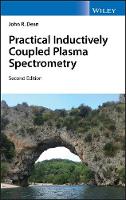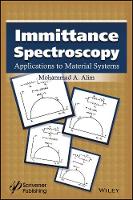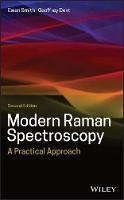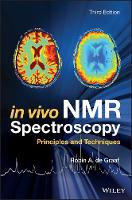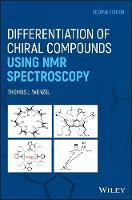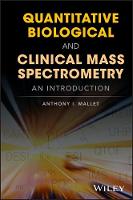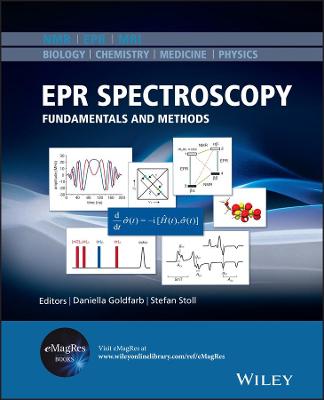Nuclear Magnetic Resonance Spectroscopy
 -15%
portes grátis
-15%
portes grátis
Nuclear Magnetic Resonance Spectroscopy
An Introduction to Principles, Applications, and Experimental Methods
Mazzola, Eugene P.; Lambert, Joseph B.; Ridge, Clark D.
John Wiley & Sons Inc
12/2018
480
Dura
Inglês
9781119295235
15 a 20 dias
1031
Preface to Second Edition
Symbols
Abbreviations
1. Introduction
1.1. Magnetic Properties of Nuclei
1.2. The Chemical Shift
1.3. Excitation and Relaxation
1.4. Pulsed Experiments
1.5. The Coupling Constant
1.6. Quantitation and Complex Splitting
1.7. Commonly Studied Nuclides
1.8. Dynamic Effects
1.9. Spectra of Solids
Problems
Tips on Solving NMR Problems
Bibliography
2. Introductory Experimental Methods
2.1. The Spectrometer
2.2. Sample Preparation
2.3. Optimizing the Signal
2.3a. Sample Tube Placement
2.3b. Probe Tuning
2.3c. Field/Frequency Locking
2.3d. Spectrometer Shimming
2.4. Determination of NMR Spectra-Acquisition Parameters
2.4a. Number of Data Points
2.4b. Spectral Width
2.4c. Filter Bandwidth
2.4d. Acquisition Time
2.4e. Transmitter Offset
2.4f. Flip Angle
2.4g. Receiver Gain
2.4h. Number of Scans
2.4i. Steady-State Scans
2.4j. Oversampling and Digital Filtration
2.4k. Decoupling for X Nuclei
2.4l. Typical NMR Experiments
2.5. Determination of NMR Spectral-Processing Parameters
2.5a. Exponential Weighting
2.5b. Zero Filling
2.5c. FID Truncation and Spectral Artifacts
2.5d. Resolution
2.6. Determination of NMR Spectra: Spectral Presentation
2.6a. Signal Phasing and Baseline Correction
2.6b. Zero Referencing
2.6c. Determination of Certain NMR Parameters
2.7. Calibrations
2.7a. Pulse Width (Flip Angle)
2.8b. Decoupler Field Strength
Problems
Bibliography
3. The Chemical Shift
3.1. Factors That Influence Proton Shifts
3.2. Proton Chemical Shifts and Structure
3.2a. Saturated Aliphatics
3.2b. Unsaturated Aliphatics
3.2c. Aromatics
3.2d. Protons on Oxygen and Nitrogen
3.2e. Programs for Empirical Calculations
3.3. Medium and Isotope Effects
3.4. Factors That Influence Carbon Shifts
3.5. Carbon Chemical Shifts and Structure
3.5a. Saturated Aliphatics
3.5b. Unsaturated Compounds
3.5c. Carbonyl Groups
3.5d. Programs for Empirical Calculation
3.6. Tables of Chemical Shifts
Problems
Further Tips on Solving NMR Problems
Bibliography
4. The Coupling Constant
4.1. First- and Second-Order Effects
4.2. Chemical and Magnetic Equivalence
4.3. Signs and Mechanisms of Coupling
4.4. Couplings over One Bond
4.5. Geminal Couplings
4.6. Vicinal Couplings
4.7. Long-Range Couplings
4.8. Spectral Analysis
4.9. Tables of Coupling Constants
Problems
Bibliography
5. Further Topics in One-Dimensional NMR Spectroscopy
5.1. Spin-Lattice and Spin-Spin Relaxation
5.2. Reactions on the NMR Time Scale
5.3. Multiple Resonance
5.4. The Nuclear Overhauser Effect
5.5. Spectral Editing
5.6. Sensitivity Enhancement
5.7. Carbon Connectivity
5.8. Phase Cycling, Composite Pulses, and Shaped Pulses
Problems
Bibliography
6. Two-Dimensional NMR Spectroscopy
6.1. Proton-Proton Correlation Through J Coupling
6.2. Proton-Heteronucleus Correlation
6.3. Proton-Proton Correlation Through Space or Chemical Exchange
6.4. Carbon-Carbon Correlation
6.5. Higher Dimensions
6.6. Pulsed Field Gradients
6.7. Diffusion-Ordered Spectroscopy
6.7. Summary of Two-Dimensional Methods
Problems
Bibliography
7. Advanced Experimental Methods
Part A. One-Dimensional Techniques
7.1. T1 Measurements
7.2. 13C Spectral Editing Experiments
7.2a. The APT Experiment
7.2b. The DEPT Experiment
7.3. NOE Experiments
7.3a. The NOE Difference Experiment
7.3b. The Double-Pulse, Field-Gradient, Spin-Echo NOE Experiment
Part B. Two-Dimensional Techniques
7.4. Two-Dimensional NMR Data-Acquisition Parameters
7.4a. Number of Data Points
7.4b. Number of Time Increments
7.4c. Spectral Widths
7.4d. Acquisition Time
7.4e. Transmitter Offset
7.4f. Flip Angle
7.4g. Relaxation Delay
7.4h. Receiver Gain
7.4i. Number of Scans per Time Increment
7.4j. Steady-State Scans
7.5. Two-Dimensional NMR Data-Processing Parameters
7.5a. Weighting Functions
7.5b. Zero Filling
7.5c. Digital Resolution
7.5d. Linear Prediction
7.6. Two-Dimensional NMR Data Display
7.6a. Phasing and Zero Referencing
7.6b. Symmetrization
7.6c. Use of Cross Sections in Analysis
Part C. Two-Dimensional Techniques: The Experiments
7.7. Homonuclear Chemical-Shift Correlation Experiments via Scalar Coupling
7.7a. The COSY Family: COSY-90 degrees, COSY-45 degrees, Long-Range COSY, and DQF-COSY
7.7b. The TOCSY Experiment
7.8. Direct Heteronuclear Chemical-Shift Correlation via Scalar Coupling
7.8a. The HMQC Experiment
7.8b. The HSQC Experiment
7.8c. The HETCOR Experiment
7.9. Indirect Heteronuclear Chemical-Shift Correlation via Scalar Coupling
7.9a. The HMBC Experiment
7.9b. The FLOCK Experiment
7.9c. The HSQC-TOCSY Experiment
7.10. Homonuclear Chemical-Shift Correlation via Dipolar Coupling
7.10a. The NOESY Experiment
7.10b. The ROESY Experiment
7.11. 1D and Advanced 2D Experiments
7.11a. The 1D TOCSY Experiment
7.11b. The 1D NOESY and ROESY Experiments
7.11c. The Multiplicity-Edited HSQC Experiment
7.11d. The H2BC Experiment
7.11e. Nonuniform Sampling
7.11f. Pure Shift NMR
7.11g. Covariance NMR
7.12. Pure Shift-Covariance NMR
Bibliography
8. Structural Elucidation: An Example
Part A. Spectral Analysis
8.1. 1H NMR Data
8.2. 13C NMR Data
8.3. The DEPT Experiment
8.4. The HSQC Experiment
8.5. The COSY Experiment
8.6. The HMBC Experiment
8.7. General Molecular Assembly Strategy
8.8. A Specific Molecular Assembly Procedure
8.9. The NOESY Experiment
Part B Computer-Assisted Structure Elucidation
8.10. CASE Procedures
8.11. T-2 Toxin
Appendix 1 Derivation of the NMR Equation
Appendix 2 The Bloch Equations
Appendix 3 Quantum Mechanical Treatment of the Two-Spin System
Appendix 4 Analysis of Second-Order, Three- and Four-Spin Systems by Inspection
Appendix 5 Relaxation
Appendix 6 Product-Operator Formalism and Coherence-Level Diagrams
Bibliography
Appendix 7 Stereochemical Considerations
A7.1. Homotopic Groups
A7.2. Enantiotopic Groups
A7.3. Diastereotopic Groups
Bibliography
Index
Preface to Second Edition
Symbols
Abbreviations
1. Introduction
1.1. Magnetic Properties of Nuclei
1.2. The Chemical Shift
1.3. Excitation and Relaxation
1.4. Pulsed Experiments
1.5. The Coupling Constant
1.6. Quantitation and Complex Splitting
1.7. Commonly Studied Nuclides
1.8. Dynamic Effects
1.9. Spectra of Solids
Problems
Tips on Solving NMR Problems
Bibliography
2. Introductory Experimental Methods
2.1. The Spectrometer
2.2. Sample Preparation
2.3. Optimizing the Signal
2.3a. Sample Tube Placement
2.3b. Probe Tuning
2.3c. Field/Frequency Locking
2.3d. Spectrometer Shimming
2.4. Determination of NMR Spectra-Acquisition Parameters
2.4a. Number of Data Points
2.4b. Spectral Width
2.4c. Filter Bandwidth
2.4d. Acquisition Time
2.4e. Transmitter Offset
2.4f. Flip Angle
2.4g. Receiver Gain
2.4h. Number of Scans
2.4i. Steady-State Scans
2.4j. Oversampling and Digital Filtration
2.4k. Decoupling for X Nuclei
2.4l. Typical NMR Experiments
2.5. Determination of NMR Spectral-Processing Parameters
2.5a. Exponential Weighting
2.5b. Zero Filling
2.5c. FID Truncation and Spectral Artifacts
2.5d. Resolution
2.6. Determination of NMR Spectra: Spectral Presentation
2.6a. Signal Phasing and Baseline Correction
2.6b. Zero Referencing
2.6c. Determination of Certain NMR Parameters
2.7. Calibrations
2.7a. Pulse Width (Flip Angle)
2.8b. Decoupler Field Strength
Problems
Bibliography
3. The Chemical Shift
3.1. Factors That Influence Proton Shifts
3.2. Proton Chemical Shifts and Structure
3.2a. Saturated Aliphatics
3.2b. Unsaturated Aliphatics
3.2c. Aromatics
3.2d. Protons on Oxygen and Nitrogen
3.2e. Programs for Empirical Calculations
3.3. Medium and Isotope Effects
3.4. Factors That Influence Carbon Shifts
3.5. Carbon Chemical Shifts and Structure
3.5a. Saturated Aliphatics
3.5b. Unsaturated Compounds
3.5c. Carbonyl Groups
3.5d. Programs for Empirical Calculation
3.6. Tables of Chemical Shifts
Problems
Further Tips on Solving NMR Problems
Bibliography
4. The Coupling Constant
4.1. First- and Second-Order Effects
4.2. Chemical and Magnetic Equivalence
4.3. Signs and Mechanisms of Coupling
4.4. Couplings over One Bond
4.5. Geminal Couplings
4.6. Vicinal Couplings
4.7. Long-Range Couplings
4.8. Spectral Analysis
4.9. Tables of Coupling Constants
Problems
Bibliography
5. Further Topics in One-Dimensional NMR Spectroscopy
5.1. Spin-Lattice and Spin-Spin Relaxation
5.2. Reactions on the NMR Time Scale
5.3. Multiple Resonance
5.4. The Nuclear Overhauser Effect
5.5. Spectral Editing
5.6. Sensitivity Enhancement
5.7. Carbon Connectivity
5.8. Phase Cycling, Composite Pulses, and Shaped Pulses
Problems
Bibliography
6. Two-Dimensional NMR Spectroscopy
6.1. Proton-Proton Correlation Through J Coupling
6.2. Proton-Heteronucleus Correlation
6.3. Proton-Proton Correlation Through Space or Chemical Exchange
6.4. Carbon-Carbon Correlation
6.5. Higher Dimensions
6.6. Pulsed Field Gradients
6.7. Diffusion-Ordered Spectroscopy
6.7. Summary of Two-Dimensional Methods
Problems
Bibliography
7. Advanced Experimental Methods
Part A. One-Dimensional Techniques
7.1. T1 Measurements
7.2. 13C Spectral Editing Experiments
7.2a. The APT Experiment
7.2b. The DEPT Experiment
7.3. NOE Experiments
7.3a. The NOE Difference Experiment
7.3b. The Double-Pulse, Field-Gradient, Spin-Echo NOE Experiment
Part B. Two-Dimensional Techniques
7.4. Two-Dimensional NMR Data-Acquisition Parameters
7.4a. Number of Data Points
7.4b. Number of Time Increments
7.4c. Spectral Widths
7.4d. Acquisition Time
7.4e. Transmitter Offset
7.4f. Flip Angle
7.4g. Relaxation Delay
7.4h. Receiver Gain
7.4i. Number of Scans per Time Increment
7.4j. Steady-State Scans
7.5. Two-Dimensional NMR Data-Processing Parameters
7.5a. Weighting Functions
7.5b. Zero Filling
7.5c. Digital Resolution
7.5d. Linear Prediction
7.6. Two-Dimensional NMR Data Display
7.6a. Phasing and Zero Referencing
7.6b. Symmetrization
7.6c. Use of Cross Sections in Analysis
Part C. Two-Dimensional Techniques: The Experiments
7.7. Homonuclear Chemical-Shift Correlation Experiments via Scalar Coupling
7.7a. The COSY Family: COSY-90 degrees, COSY-45 degrees, Long-Range COSY, and DQF-COSY
7.7b. The TOCSY Experiment
7.8. Direct Heteronuclear Chemical-Shift Correlation via Scalar Coupling
7.8a. The HMQC Experiment
7.8b. The HSQC Experiment
7.8c. The HETCOR Experiment
7.9. Indirect Heteronuclear Chemical-Shift Correlation via Scalar Coupling
7.9a. The HMBC Experiment
7.9b. The FLOCK Experiment
7.9c. The HSQC-TOCSY Experiment
7.10. Homonuclear Chemical-Shift Correlation via Dipolar Coupling
7.10a. The NOESY Experiment
7.10b. The ROESY Experiment
7.11. 1D and Advanced 2D Experiments
7.11a. The 1D TOCSY Experiment
7.11b. The 1D NOESY and ROESY Experiments
7.11c. The Multiplicity-Edited HSQC Experiment
7.11d. The H2BC Experiment
7.11e. Nonuniform Sampling
7.11f. Pure Shift NMR
7.11g. Covariance NMR
7.12. Pure Shift-Covariance NMR
Bibliography
8. Structural Elucidation: An Example
Part A. Spectral Analysis
8.1. 1H NMR Data
8.2. 13C NMR Data
8.3. The DEPT Experiment
8.4. The HSQC Experiment
8.5. The COSY Experiment
8.6. The HMBC Experiment
8.7. General Molecular Assembly Strategy
8.8. A Specific Molecular Assembly Procedure
8.9. The NOESY Experiment
Part B Computer-Assisted Structure Elucidation
8.10. CASE Procedures
8.11. T-2 Toxin
Appendix 1 Derivation of the NMR Equation
Appendix 2 The Bloch Equations
Appendix 3 Quantum Mechanical Treatment of the Two-Spin System
Appendix 4 Analysis of Second-Order, Three- and Four-Spin Systems by Inspection
Appendix 5 Relaxation
Appendix 6 Product-Operator Formalism and Coherence-Level Diagrams
Bibliography
Appendix 7 Stereochemical Considerations
A7.1. Homotopic Groups
A7.2. Enantiotopic Groups
A7.3. Diastereotopic Groups
Bibliography
Index

